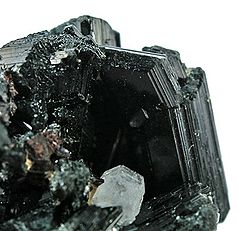| Chloritoid | |
|---|---|
 Chloritoid crystal group on matrix from Nuristan Province, Afghanistan (size:6.3 x 3.5 x 3.0 cm) | |
| General | |
| Category | Nesosilicates |
| Formula | (Fe,Mg,Mn) 2Al 4Si 2O 10(OH) 4 |
| IMA symbol | Cld [1] |
| Strunz classification | 9.AF.85 |
| Dana classification | 52.03.03.01 |
| Crystal system | 1A polytype: triclinic 2M polytype: monoclinic |
| Crystal class | 1A polytype: pinacoidal (1) 2M polytype: prismatic (2/m) |
| Unit cell | 1A polytype: a = 9.46 Å, b = 5.50 Å, c = 9.15 Å; α = 97.05°, β = 101.56°, γ = 90.10° 2M polytype: a = 9.50 Å, b = 5.50 Å, c = 18.22 Å; β = 101.9°; Z = 4 |
| Identification | |
| Color | Dark gray, greenish gray, greenish black |
| Crystal habit | Tabular pseudohexagonal crystals; rosettes, commonly coarsely foliated with foliae typically curved or bent; also massive |
| Twinning | Common on {001}, polysynthetic may be lamellar |
| Cleavage | Perfect on {001}, distinct on {110}; parting on {010} |
| Tenacity | Brittle |
| Mohs scale hardness | 6.5 |
| Luster | pearly on cleavage surfaces |
| Streak | White, grayish, or very slightly greenish |
| Diaphaneity | Translucent |
| Specific gravity | 3.46 – 3.80 |
| Optical properties | Biaxial (+) or (−) |
| Refractive index | nα = 1.713 – 1.730 nβ = 1.719 – 1.734 nγ = 1.723 – 1.740 |
| Birefringence | δ = 0.010 |
| Pleochroism | X = olive-green to yellow; Y = grayish blue to blue; Z = colorless to pale greenish yellow |
| 2V angle | Measured: 36° to 89° |
| Dispersion | r > v; strong |
| References | [2] [3] [4] |
Chloritoid is a silicate mineral of metamorphic origin. It is an iron magnesium manganese alumino-silicate hydroxide with formula (Fe, Mg, Mn)
2 Al
4 Si
2 O
10(OH)
4. It occurs as greenish grey to black platy micaceous crystals and foliated masses. Its Mohs hardness is 6.5, unusually high for a platy mineral, and it has a specific gravity of 3.52 to 3.57. It typically occurs in phyllites, schists and marbles.
Both monoclinic and triclinic polytypes exist and both are pseudohexagonal. [2] [3]
It was first described in 1837 from localities in the Ural Mountains region of Russia. It was named for its similarity to the chlorite group of minerals. [3] [4]